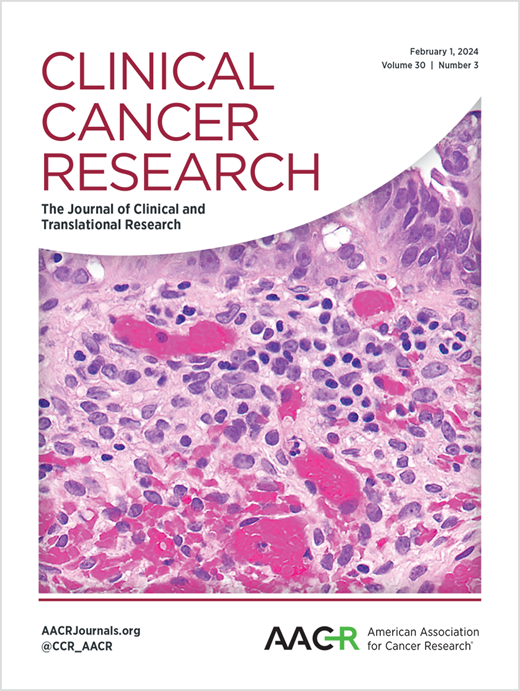HIGH-DOSE CHEMOTHERAPY FOR MULTIPLY OR POOR-RISK RELAPSED GERM-CELL TUMORS
IF 10.2
1区 医学
Q1 ONCOLOGY
引用次数: 0
Abstract
Purpose: Sequential high-dose chemotherapy (HDC) using carboplatin/etoposide (CE) with autologous stem-cell transplant can be curative in relapsed germ-cell tumors (GCT). However, outcomes are poor for multiply relapsed/refractory tumors. We studied gemcitabine/docetaxel/melphalan/carboplatin (GemDMC), which exploits DNA damage repair inhibition. We hypothesized that concurrent bevacizumab, targeting the high vascularity of GCT, would synergize with HDC. Methods: Trial eligibility included 2nd or later relapse or poor-risk 1st relapse, and adequate end-organ function. Treatment consisted of sequential bevacizumab-GemDMC (HDC cycle 1, C1) and bevacizumab-ifosfamide/carboplatin/etoposide (ICE) (C2), in 3 consecutive cohorts: bevacizumab/full-dose GemDMC (cohort 1), bevacizumab/reduced-dose GemDMC (cohort 2), and no bevacizumab/reduced-dose GemDMC (cohort 3). The trial was powered to distinguish a target 50% 2-year RFS rate from an expected <25%. We validated its results in an off-trial 4th cohort treated the same as cohort 3. Findings: We treated 165 male patients (65 trial, 100 cohort 4), after a median of 3 prior therapy lines; mostly cisplatin-refractory tumors at relapse (45% refractory, 23% absolutely refractory); 19% primary mediastinal tumors. Overall response rate: 84.5% (77% CR/PRm-). The treatment-related mortality rates in cohorts 1 to 4 were 13%, 8%, 4%, and 4%, respectively. Resection of residual lesions in 74 patients found no viable GCT in 76%. The 5-year RFS and overall survival rates were 57.1% and 58.3%, respectively, without differences between trial and cohort 4 patients, or between patients receiving bevacizumab (cohorts 1/2) or not (cohorts 3/4). Conclusions: Sequential GemDMC-(I)CE in multiply poor-risk relapsed GCT shows outcomes that exceed the anticipated results. Bevacizumab did not improve outcomes.多发或低风险复发生殖细胞肿瘤的大剂量化疗
目的:卡铂/依托泊苷序贯大剂量化疗(HDC)联合自体干细胞移植治疗复发性生殖细胞瘤(GCT)是可行的。然而,多次复发/难治性肿瘤的预后很差。我们研究了吉西他滨/多西他赛/美法兰/卡铂(GemDMC),利用DNA损伤修复抑制。我们假设同时使用贝伐单抗,针对GCT的高血管性,将与HDC协同作用。方法:试验资格包括第二次或以后复发或低风险第一次复发,终末器官功能充足。治疗包括顺序贝伐单抗-GemDMC (HDC周期1,C1)和贝伐单抗-异环酰胺/卡铂/依托泊苷(ICE) (C2),在3个连续队列中:贝伐单抗/全剂量GemDMC(队列1),贝伐单抗/减少剂量GemDMC(队列2)和无贝伐单抗/减少剂量GemDMC(队列3)。该试验能够区分目标2年RFS率为50%和预期的25%。我们在与队列3处理相同的非试验第4队列中验证了其结果。研究结果:我们治疗了165名男性患者(65项试验,100个队列4),中位数为3个先前的治疗线;大多数是复发时的顺铂难治性肿瘤(45%难治性,23%绝对难治性);19%为原发性纵隔肿瘤。总有效率:84.5% (77% CR/PRm-)。在队列1至4中,治疗相关死亡率分别为13%、8%、4%和4%。74例患者切除残余病变后,76%的患者未发现可存活的GCT。5年RFS和总生存率分别为57.1%和58.3%,试验和队列4患者之间,或接受贝伐单抗(队列1/2)或未接受贝伐单抗(队列3/4)的患者之间无差异。结论:在多次低风险复发的GCT中,序贯GemDMC-(I)CE显示出超出预期的结果。贝伐单抗没有改善结果。
本文章由计算机程序翻译,如有差异,请以英文原文为准。
求助全文
约1分钟内获得全文
求助全文
来源期刊

Clinical Cancer Research
医学-肿瘤学
CiteScore
20.10
自引率
1.70%
发文量
1207
审稿时长
2.1 months
期刊介绍:
Clinical Cancer Research is a journal focusing on groundbreaking research in cancer, specifically in the areas where the laboratory and the clinic intersect. Our primary interest lies in clinical trials that investigate novel treatments, accompanied by research on pharmacology, molecular alterations, and biomarkers that can predict response or resistance to these treatments. Furthermore, we prioritize laboratory and animal studies that explore new drugs and targeted agents with the potential to advance to clinical trials. We also encourage research on targetable mechanisms of cancer development, progression, and metastasis.
 求助内容:
求助内容: 应助结果提醒方式:
应助结果提醒方式:


